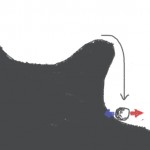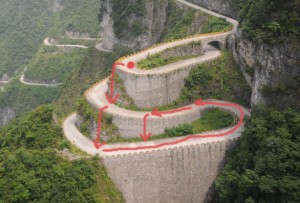Recently a radically new biophysical theory of action potentials has been proposed, which I will call here the “soliton theory”, according to which action potential propagation is a travelling pulse (soliton) of membrane (lipidic) lateral density, i.e., a sound wave along the axon membrane (Heimburg and Jackson, 2005; Andersen et al., 2009). In this theory, the lipid membrane undergoes a phase transition, from liquid to gel, which propagates along the axon. The electrical spike is then attributed to piezoelectric effects (mechanical changes inducing electrical potential changes). No role is attributed to proteins (ionic channels).
I start with some positive comments. Usually only the electrochemical aspects of neural excitability are considered in the field. But it is known that the electrical phenomenon is accompanied by mechanical, optical and thermal effects, which are the main focus of the soliton theory. The theory also has the merit of bringing attention to non-electrical phenomena in biological membranes, such as structural changes and mechanical effects, which are typically ignored in the field.
The theory appears to be motivated by the observation of reversible heat release during the action potential, i.e., heat is released in the rising phase of the spike and absorbed in the falling phase. Quantitatively, release and absorption have the same magnitude (experimental precision being in the range of 10-20% according to the original papers). This is not explained by HH theory. It does not mean, however, that it is contradictory with HH theory; rather, it would require some additional mechanism that is not part of the theory (there are some speculations in the literature, by Hodgkin, Keynes, Tasaki, and probably others). HH theory does not directly address mechanical changes accompanying the spike, but it does imply mechanical changes by at least two plausible mechanisms: 1) osmotic effects, i.e., water enters the cell along with Na+ influx, and exist with K+ outflux, leading to a diameter variation in phase with the spike (see e.g. (Kim et al., 2007); 2) an electrical field applied on the membrane can change the curvature of the membrane. The appeal of the soliton theory is that a sound wave produces reversible heat and mechanical variations; electrical variation is attributed to piezoelectric effects and therefore all these effects should be in phase. Thus in a way, it has some theoretical elegance. Of course, the actual biophysical mechanisms are not necessary elegant.
Let us now examine the premises and predictions of the theory. First, it is assumed that the lipidic membrane is close to a melting transition, which the authors claim occurs slightly below the body temperature of 37°C. It is rather surprising to read this starting point when the theory is meant to address the shortcomings of the HH model. Let us recall that the HH model is a model of the giant axon of squid, which is a cold-blooded animal living in the ocean. Body temperature is thus much colder and variable. But this is not the most problematic aspect of the theory; let us assume for now that the squid membrane does have the required property.
The main quantitative prediction of the theory is conduction velocity, which follows from membrane properties, and it is calculated to be around 100 m/s. The conclusion is that there is “a minimum velocity of the solitons that is close to the propagation velocity in myelinated nerves”. First, the squid axon is not myelinated (it is anyway not clear why the theory should apply to myelinated nerves rather than unmyelinated ones), and conduction velocity is around 20 m/s. In any case, 100 m/s is not the propagation velocity in myelinated nerves. It is the upper bound of conduction velocity in nerve, which varies over several orders of magnitude and is much smaller for most axons. It actually varies with diameter, quite in line with predictions from HH and cable theory (scaling with square root of diameter for unmyelinated axons; with diameter for myelinated axons). One of the main predictions of the 1952 HH paper where the model is described is conduction velocity, which is accurate within 20% (Hodgkin and Huxley, 1952); to be compared with 500% error in the soliton theory. The prediction was calculated as follows (see chapter 3 of my book in progress): the HH model was built and fitted on a space-clamped (isopotential) squid axon; then it was extended to a model of propagating spike with the cable formalism, ie by adding the axial current term (based on measurement of diameter and intracellular resistivity); then the model was run and a conduction velocity of around 20 m/s was found.
If one of the main predictions of the soliton theory is a minimum conduction velocity of around 100 m/s, then it is definitely wrong. There are of course many other aspects of the theory that are very problematic. HH theory is essentially the ionic hypothesis, ie the idea that changes in membrane potential are due to ionic and capacitive transmembrane currents. There have been numerous quantitative tests of this hypothesis, such as: the peak of the spike is well predicted by the Nernst potential of Na+, the influx of Na+ and outflux of K+ per spike (measured with radioactive tracers) are predicted by the HH model; fluorescence imaging now shows influxes of Na+ in phase with spikes. Early work by HH and colleagues have showed that the squid axon is inexcitable when extracellular Na+ is replaced by choline. All this body of work, which includes many accurate quantitative predictions of HH theory, is contradictory with the soliton theory. The authors seem to deny the existence of ionic channels, which is extremely strange. The detailed molecular and genetic structure of ionic channels is known, as well as their electrophysiological properties (see e.g. (Hille, 2001)); drugs targetting Na+ channels (for which there is huge empirical evidence) block action potentials. There is also the Na/K pump, a major contributor of energy consumption in neurons, which maintains the Na+/K+ concentration gradients necessary in the ionic hypothesis, and which seems totally absurd in the soliton theory.
As it stands, the soliton theory of spikes is contradictory with an extremely large body of experimental evidence, which is explained by HH theory (ie the ionic hypothesis) (note that there have been a number of alternative theories, eg by Ling and Tasaki).
Update (21.7.2016): A great resource about the evidence in favor of the ionic hypothesis is (Hodgkin, 1951). There is in fact a section dealing with heat production, where it is by the way noted that overall nerve activity does produce heat, but a quite small amount. It is also clear in the text that heat production in the ionic hypothesis is not that of the equivalent electrical circuit that is used to present the HH model – which is only equivalent in terms of the mathematical equations describing the currents, not physically. That is, the axial current does follow the expectation from the electrical circuit, since in the theory it is due to the electrical field in an electrolyte, but not the transmembrane current, which corresponds to mixing of extra- and intra-cellular solutions in addition to field effects (plus the at the time unknown mechanisms of permeability changes).
Andersen SSL, Jackson AD, Heimburg T (2009) Towards a thermodynamic theory of nerve pulse propagation. Prog Neurobiol 88:104–113.
Heimburg T, Jackson AD (2005) On soliton propagation in biomembranes and nerves. Proc Natl Acad Sci U S A 102:9790–9795.
Hille B (2001) Ion Channels of Excitable Membranes. Sinauer Associates.
Hodgkin A, Huxley A (1952) A quantitative description of membrane current and its application to conduction and excitation in nerve. J Physiol Lond 117:500.
Hodgkin AL (1951) The Ionic Basis of Electrical Activity in Nerve and Muscle. Biol Rev 26:339–409.
Kim GH, Kosterin P, Obaid AL, Salzberg BM (2007) A mechanical spike accompanies the action potential in Mammalian nerve terminals. Biophys J 92:3122–3129.



